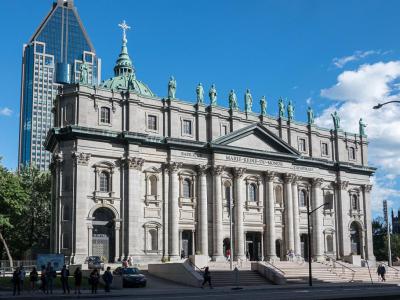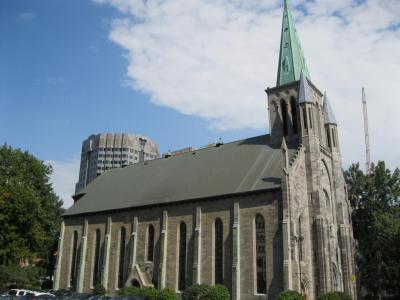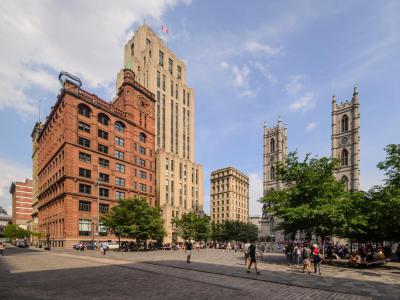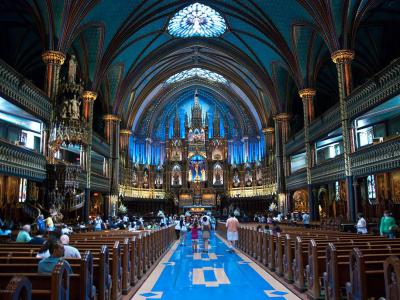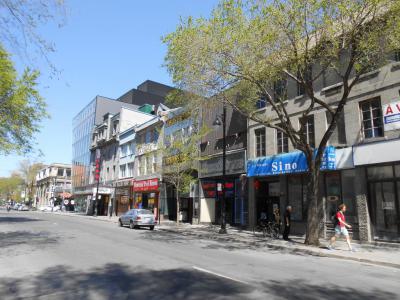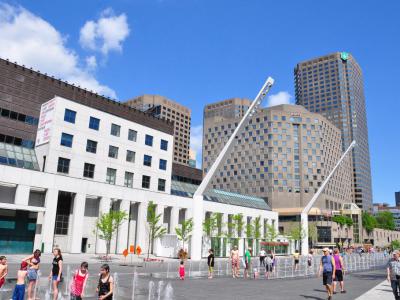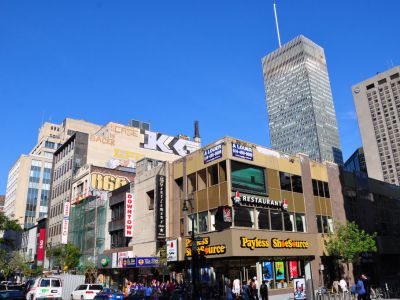Montreal Introduction Walking Tour (Self Guided), Montreal
The second-most populous city in Canada, Montreal is an old, yet at the same time, modern metropolis, flagship of Canada's Québec province. Sitting on an island in the Saint Lawrence River, with Mount Royal at its center, the city owes its name to this triple-peaked hill (Mont Royal in modern French, although in 16th-century French the forms réal and royal were used interchangeably).
The First Nations (Indigenous Canadian peoples) occupied the island as early as 4,000 years ago. In 1611, French explorer Samuel de Champlain established here a fur trading post. A group of colonists from La Flèche (in the Loire valley of France) arrived on the island in 1642. The settlers founded on its southern shore a new town called Ville-Marie ("City of Mary"), named for the Virgin Mary.
The settlement appeared as Ville-Marie in all official documents until 1705, when Montreal appeared for the first time, although people had referred to it as the "Island of Montreal" long before then. Montreal was incorporated as a city in 1832, and from 1844 to 1849 was the capital of the Province of Canada (British colony in North America). For over a century and a half, Montreal was the industrial, financial and commercial center of Canada, surpassed in population and economic strength by Toronto only in the 1970s. This legacy has left a wealth of notable attractions and a blend of architectural moods, from French colonial to bohemian, providing an invaluable insight into the city's past.
Historically, Montreal has been a center of Catholicism in North America with its numerous seminaries and churches, including the Notre-Dame Basilica, St Patrick's Basilica, and the Cathédrale Marie-Reine-du-Monde. Nicknamed la ville aux cent clochers (“the city of a hundred steeples”), Mark Twain once noted about it, "This is the first time I was ever in a city where you couldn't throw a brick without breaking a church window."
A cultural heart of Montreal's classical art and the venue for many summer festivals is Place des Arts, a large square in the eastern portion of downtown.
The city is composed of 19 large boroughs, many of which were once independent cities, subdivided into neighborhoods. The borough with the most neighborhoods is Ville Marie, which includes downtown, Vieux-Montréal (Old Montreal), Chinatown, and others. The cobblestoned, French colonial Old Montreal is a historic area containing many attractions such as the Old Port of Montreal, Place Jacques-Cartier, Montreal City Hall (the seat of local government), Place d'Armes and more.
The 21st-century Montréal remains an important hub of commerce, aerospace, transport, finance, pharmaceuticals, technology, design, education, art, culture, tourism, food, fashion, video game development, film, and world affairs.
To appreciate this beautiful city in its entirety, take our self-guided introductory walk and enjoy its atmosphere to the fullest!
The First Nations (Indigenous Canadian peoples) occupied the island as early as 4,000 years ago. In 1611, French explorer Samuel de Champlain established here a fur trading post. A group of colonists from La Flèche (in the Loire valley of France) arrived on the island in 1642. The settlers founded on its southern shore a new town called Ville-Marie ("City of Mary"), named for the Virgin Mary.
The settlement appeared as Ville-Marie in all official documents until 1705, when Montreal appeared for the first time, although people had referred to it as the "Island of Montreal" long before then. Montreal was incorporated as a city in 1832, and from 1844 to 1849 was the capital of the Province of Canada (British colony in North America). For over a century and a half, Montreal was the industrial, financial and commercial center of Canada, surpassed in population and economic strength by Toronto only in the 1970s. This legacy has left a wealth of notable attractions and a blend of architectural moods, from French colonial to bohemian, providing an invaluable insight into the city's past.
Historically, Montreal has been a center of Catholicism in North America with its numerous seminaries and churches, including the Notre-Dame Basilica, St Patrick's Basilica, and the Cathédrale Marie-Reine-du-Monde. Nicknamed la ville aux cent clochers (“the city of a hundred steeples”), Mark Twain once noted about it, "This is the first time I was ever in a city where you couldn't throw a brick without breaking a church window."
A cultural heart of Montreal's classical art and the venue for many summer festivals is Place des Arts, a large square in the eastern portion of downtown.
The city is composed of 19 large boroughs, many of which were once independent cities, subdivided into neighborhoods. The borough with the most neighborhoods is Ville Marie, which includes downtown, Vieux-Montréal (Old Montreal), Chinatown, and others. The cobblestoned, French colonial Old Montreal is a historic area containing many attractions such as the Old Port of Montreal, Place Jacques-Cartier, Montreal City Hall (the seat of local government), Place d'Armes and more.
The 21st-century Montréal remains an important hub of commerce, aerospace, transport, finance, pharmaceuticals, technology, design, education, art, culture, tourism, food, fashion, video game development, film, and world affairs.
To appreciate this beautiful city in its entirety, take our self-guided introductory walk and enjoy its atmosphere to the fullest!
How it works: Download the app "GPSmyCity: Walks in 1K+ Cities" from Apple App Store or Google Play Store to your mobile phone or tablet. The app turns your mobile device into a personal tour guide and its built-in GPS navigation functions guide you from one tour stop to next. The app works offline, so no data plan is needed when traveling abroad.
Montreal Introduction Walking Tour Map
Guide Name: Montreal Introduction Walking Tour
Guide Location: Canada » Montreal (See other walking tours in Montreal)
Guide Type: Self-guided Walking Tour (Sightseeing)
# of Attractions: 11
Tour Duration: 2 Hour(s)
Travel Distance: 3.6 Km or 2.2 Miles
Author: doris
Sight(s) Featured in This Guide:
Guide Location: Canada » Montreal (See other walking tours in Montreal)
Guide Type: Self-guided Walking Tour (Sightseeing)
# of Attractions: 11
Tour Duration: 2 Hour(s)
Travel Distance: 3.6 Km or 2.2 Miles
Author: doris
Sight(s) Featured in This Guide:
- Mary, Queen of the World Cathedral (Cathedrale Marie-Reine-du-Monde)
- Place Ville-Marie
- St. Patrick's Basilica
- Arms' Square (Place d'Armes)
- Notre-Dame Basilica
- Place Jacques-Cartier
- City Hall (Hotel de Ville)
- Chinatown
- Saint-Laurent Boulevard
- Place des Arts
- Ste-Catherine Street (Rue Ste-Catherine)
1) Mary, Queen of the World Cathedral (Cathedrale Marie-Reine-du-Monde) (must see)
Montréal has many beautiful churches and this is one of those that you should see when visiting downtown. Despite being nestled among many high-rise structures, its dome is unmistakable, modeled on Saint Peter's in Rome. Though somewhat “scaled-down”, the church is a perfect replica of the same, right down to the red copper baldachin over the altar that was fully hand-carved in Rome.
Dating back to in the 1890s, the cathedral appears older than its years, while at the same time feeling relatively modern as compared to Notre-Dame across town or even other cathedrals in other major cities – mostly due to the cleaner, simpler design. While not particularly ornate, the interior is still pretty, marked by soft hues that lend a gentle and slightly feminine touch. On a sunny day, the brilliant colors of the stained glass windows make it easy to observe the details – from the vibrant ceiling to the altar and the beautiful organ pipes at the back. You may also notice the baptismal font is surmounted by an impressive stucco crucifix – one of the most important pieces of religious sculpture in Quebec.
While the floor and walls are covered in Italian marble the main works of art are dedicated to the city's devout Catholics, including depictions of Marguerite Bourgeoys and Grey Nuns founder Marguerite d'Youville. Like Saint Peter's, the cathedral also has 13 statues that adorn the facade, but breaking with tradition they do not represent Jesus and the 12 apostles. Instead, they represent the patron saints of parishes that offered them to the diocese and include Saint Hyacinthe, Saint Francis of Assisi, and Saint John the Baptist.
Why You Should Visit:
Peaceful and ornate, this Cathedral will make you feel as if you are in an old basilica in Europe.
Tip:
Don't forget to check the gift shop that has many unique gift and jewelry items.
Dating back to in the 1890s, the cathedral appears older than its years, while at the same time feeling relatively modern as compared to Notre-Dame across town or even other cathedrals in other major cities – mostly due to the cleaner, simpler design. While not particularly ornate, the interior is still pretty, marked by soft hues that lend a gentle and slightly feminine touch. On a sunny day, the brilliant colors of the stained glass windows make it easy to observe the details – from the vibrant ceiling to the altar and the beautiful organ pipes at the back. You may also notice the baptismal font is surmounted by an impressive stucco crucifix – one of the most important pieces of religious sculpture in Quebec.
While the floor and walls are covered in Italian marble the main works of art are dedicated to the city's devout Catholics, including depictions of Marguerite Bourgeoys and Grey Nuns founder Marguerite d'Youville. Like Saint Peter's, the cathedral also has 13 statues that adorn the facade, but breaking with tradition they do not represent Jesus and the 12 apostles. Instead, they represent the patron saints of parishes that offered them to the diocese and include Saint Hyacinthe, Saint Francis of Assisi, and Saint John the Baptist.
Why You Should Visit:
Peaceful and ornate, this Cathedral will make you feel as if you are in an old basilica in Europe.
Tip:
Don't forget to check the gift shop that has many unique gift and jewelry items.
2) Place Ville-Marie
The Place Ville-Marie skyscraper in Montréal has been a source of controversy due to its close proximity to many of the city's landmarks and the significant changes it would bring to the downtown core. The project was part of Mayor Jean Drapeau's vision to transform Montréal into a modern metropolis, and he personally chose the name to pay homage to the city's French Catholic colony established in 1642.
The skyscraper was intended to house the headquarters of the Royal Bank of Canada, which it still does today, leading to the relocation of the city's financial district from Old Montréal to downtown. It became the largest and most intricate office building the world had ever seen.
While the name "Place Ville Marie" commonly refers to the cruciform building itself, it also encompasses the four smaller office buildings constructed around it in 1963 and 1964, as well as the urban plaza situated atop the main section of the shopping promenade and between the buildings.
Renowned architects I. M. Pei and Henry N. Cobb designed this international-style structure, which was completed in 1962. At the time, it was the tallest building in the British Commonwealth and the only cruciform building in the city.
Originally, the location of Place Ville-Marie was occupied by a large railway trench. Consequently, much of the building was erected above the tracks, requiring it to be exceptionally resilient to vibrations. As a result, it stands as Montreal's most earthquake-resistant office tower.
The complex is the heart of Montréal's Underground City, the world's busiest. It connects to over 1,600 businesses, subway stations, and a vast downtown tunnel network. A rooftop beacon shines white beams, visible up to 50 kilometers (31 miles) away.
Tip:
If you visit during Christmas, you will find a huge Christmas tree at the central court.
The skyscraper was intended to house the headquarters of the Royal Bank of Canada, which it still does today, leading to the relocation of the city's financial district from Old Montréal to downtown. It became the largest and most intricate office building the world had ever seen.
While the name "Place Ville Marie" commonly refers to the cruciform building itself, it also encompasses the four smaller office buildings constructed around it in 1963 and 1964, as well as the urban plaza situated atop the main section of the shopping promenade and between the buildings.
Renowned architects I. M. Pei and Henry N. Cobb designed this international-style structure, which was completed in 1962. At the time, it was the tallest building in the British Commonwealth and the only cruciform building in the city.
Originally, the location of Place Ville-Marie was occupied by a large railway trench. Consequently, much of the building was erected above the tracks, requiring it to be exceptionally resilient to vibrations. As a result, it stands as Montreal's most earthquake-resistant office tower.
The complex is the heart of Montréal's Underground City, the world's busiest. It connects to over 1,600 businesses, subway stations, and a vast downtown tunnel network. A rooftop beacon shines white beams, visible up to 50 kilometers (31 miles) away.
Tip:
If you visit during Christmas, you will find a huge Christmas tree at the central court.
3) St. Patrick's Basilica (must see)
Built in 1847, during the Famine Migration from Ireland, Saint Patrick's is to Montréal's Anglophone Catholics what the Notre-Dame Basilica is to their French-speaking brethren. Among the country's purest examples of the Gothic Revival style, it was declared a historic monument and a National Historic site of Canada in 1996. A true feast for the eyes, you will gorge on its magnificent beauty and revel in the intricate ornate details imbued within.
Stained glass windows adorn the basilica throughout its corners and walls, and on a sunny day, the interior blossoms into a dazzling cornucopia of colour. The tall, slender columns are actually pine logs lashed together and decorated to look like marble, lending an air of majesty and solemness. Another major attraction is the large hanging lamp weighing 1,800 pounds, with six angels adorning the perimeter. You've never seen anything quite like it.
Why You Should Visit:
Not as opulent as Notre-Dame, but lovely on its own. It's lighter and brighter, with glorious woodwork and other details.
On a sunny day, the stained glass windows and Gothic architecture are textbook perfect and golden in hue.
Plus, the place is free to visit and you'll probably be the only tourist there, free to sit and contemplate.
Tip:
Visit after lunch and you might catch the organist practicing for upcoming services.
A side door is usually unlocked most days in case you can't get through the main entrance.
Stained glass windows adorn the basilica throughout its corners and walls, and on a sunny day, the interior blossoms into a dazzling cornucopia of colour. The tall, slender columns are actually pine logs lashed together and decorated to look like marble, lending an air of majesty and solemness. Another major attraction is the large hanging lamp weighing 1,800 pounds, with six angels adorning the perimeter. You've never seen anything quite like it.
Why You Should Visit:
Not as opulent as Notre-Dame, but lovely on its own. It's lighter and brighter, with glorious woodwork and other details.
On a sunny day, the stained glass windows and Gothic architecture are textbook perfect and golden in hue.
Plus, the place is free to visit and you'll probably be the only tourist there, free to sit and contemplate.
Tip:
Visit after lunch and you might catch the organist practicing for upcoming services.
A side door is usually unlocked most days in case you can't get through the main entrance.
4) Arms' Square (Place d'Armes)
One of the oldest public sites in Montreal, Arms' Square (Place d'Armes) has a rather epic history to it, dating back over 300 years. This is the third location in Montreal to bear such a name, which is a French term long used to denote an assembly point for city defenders. In line with this, the square is anchored by a monument of Paul de Chomedey de Maisonneuve, the French officer and founder of Montreal. Erected in 1895, the statue commemorates Chomedey's defense of the young Ville-Marie settlement against the Iroquois Indians.
Originally, when first built in 1693, the place was called Factory Square (Place de la Fabrique) and was renamed Arms' Square only in 1721 when it became a stage for military drills, parades, and suchlike events. From 1781 to 1813, the site was used as a hay and wood market and later developed as a Victorian garden, after being acquired by the city in 1836. The square took its current shape in 1850 when Notre Dame Street was completed.
However, its real significance comes not so much from the spot itself as from what surrounds it. The structures bordering Arms' Square on all sides define Montreal's diverse heritage and represent major periods of the city's development. Primarily, these are the Notre Dame Basilica and the Saint Sulpice Seminary, Montréal's oldest building, constructed in the 1680s.
Other structures of note include the Bank of Montreal head office – Canada's first bank – opened in 1859, and the New York Life Building – Montreal's first skyscraper – constructed in 1887 and furnished with an elevator that was quite a novelty at that time. Across the way, the Royal Trust and the Duluth Building (to the left of the basilica) are the two early-20th-century high-risers that mark a distinct architectural shift, cemented with the arrival, in 1931, of the Art-Deco-style Aldred Building, designed to ensure maximum natural lighting for the streets below. Another landmark, a post-war glass and steel structure, the only one of its kind in the city, now known as the National Bank Tower, completed the square's architectural timeline in 1968.
Directly in front of it, you will find two sculptures: a caricature of a haughty Englishman with a pug, and one of a French woman with a poodle. While the dogs eye each other with eagerness to play, the lady gives an evident look of disdain towards the symbol of English power (that is the old Bank of Montreal), while the gentleman looks down his nose at the Notre Dame Basilica, symbolizing historical French influence in the region.
The pedestrian-friendly square is also a departure point for horse-drawn tours of Old Montreal. Fitted with sprawling benches which offer relief from the surrounding concrete, it is a beautiful place to stop, have a coffee or snack and marvel at the historical surroundings.
Originally, when first built in 1693, the place was called Factory Square (Place de la Fabrique) and was renamed Arms' Square only in 1721 when it became a stage for military drills, parades, and suchlike events. From 1781 to 1813, the site was used as a hay and wood market and later developed as a Victorian garden, after being acquired by the city in 1836. The square took its current shape in 1850 when Notre Dame Street was completed.
However, its real significance comes not so much from the spot itself as from what surrounds it. The structures bordering Arms' Square on all sides define Montreal's diverse heritage and represent major periods of the city's development. Primarily, these are the Notre Dame Basilica and the Saint Sulpice Seminary, Montréal's oldest building, constructed in the 1680s.
Other structures of note include the Bank of Montreal head office – Canada's first bank – opened in 1859, and the New York Life Building – Montreal's first skyscraper – constructed in 1887 and furnished with an elevator that was quite a novelty at that time. Across the way, the Royal Trust and the Duluth Building (to the left of the basilica) are the two early-20th-century high-risers that mark a distinct architectural shift, cemented with the arrival, in 1931, of the Art-Deco-style Aldred Building, designed to ensure maximum natural lighting for the streets below. Another landmark, a post-war glass and steel structure, the only one of its kind in the city, now known as the National Bank Tower, completed the square's architectural timeline in 1968.
Directly in front of it, you will find two sculptures: a caricature of a haughty Englishman with a pug, and one of a French woman with a poodle. While the dogs eye each other with eagerness to play, the lady gives an evident look of disdain towards the symbol of English power (that is the old Bank of Montreal), while the gentleman looks down his nose at the Notre Dame Basilica, symbolizing historical French influence in the region.
The pedestrian-friendly square is also a departure point for horse-drawn tours of Old Montreal. Fitted with sprawling benches which offer relief from the surrounding concrete, it is a beautiful place to stop, have a coffee or snack and marvel at the historical surroundings.
5) Notre-Dame Basilica (must see)
The Notre Dame Basilica of Montreal (Basilique Notre-Dame de Montréal) is a stunning piece of Gothic Revival architecture. Designed by the Irish-American architect James O'Donnell, it was completed, for the most part, in 1829.
The sanctuary was constructed a year later, while the first and second towers were added in 1841 and 1843, respectively. Both towers have bells: the West Tower (La Persévérance), has a bourdon bell nicknamed Jean-Baptiste. It was cast in John Dod Ward’s Eagle Foundry in 1848 and weighs 10,900 kg. Jean-Baptiste tolls only on special occasions, such as funerals, great religious festivals, and Christmas Eve. The East Tower (La Temperance), houses a ten-bell carillon from the same foundry, made in 1842.
The facade of the church was completed in 1865 and includes, among other features, three statues by the French sculptor Henri Bouriché, namely: the Virgin Mary (representing Montreal), Saint John the Baptist (representing Quebec), and Saint Joseph (representing Canada).
The interior – colorful and lavish – took much longer to complete and is quite impressive with its richly decorated columns, intricate wood carvings, statues, and elaborate stained glass windows. Quite unusual for a church, the stained glass windows here depict scenes from the history of Montreal rather than biblical scenes. Another spectacular highlight of the basilica is the Casavant Frères pipe organ, created in 1891, which is one of the largest organs in North America, comprising four keyboards and 7,000 individual pipes.
The Notre-Dame church was raised to the status of a minor basilica, by Pope John Paul II, in 1982 and was designated a National Historic Site of Canada in 1989.
Today, the Notre Dame of Montreal is a popular landmark, attracting yearly more than 11 million tourists from around the globe, making it one of the most visited sites in North America. Even the $10 admission fee doesn't turn visitors away.
Over the years, the basilica has hosted a number of important events, such as Céline Dion's wedding in 1994 and the funeral of the former Canadian Prime Minister, Pierre Trudeau, in 2000.
If you're interested in classical and religious music, the basilica offers musical programming of choral and organ performances, including Handel's Messiah every Christmas.
Tip:
The provided on-site brochure is very informative and can be used as a self-guide. Additionally, there's a free 20-minute English/French tour available at entry.
The 'AURA' light show (starting usually at 7 and 9 pm) is exceptional but often sold out, so plan your visit in advance: you can book a ticket online or come early to get a place. Try sitting somewhere in the middle to get the best music & light experience.
The sanctuary was constructed a year later, while the first and second towers were added in 1841 and 1843, respectively. Both towers have bells: the West Tower (La Persévérance), has a bourdon bell nicknamed Jean-Baptiste. It was cast in John Dod Ward’s Eagle Foundry in 1848 and weighs 10,900 kg. Jean-Baptiste tolls only on special occasions, such as funerals, great religious festivals, and Christmas Eve. The East Tower (La Temperance), houses a ten-bell carillon from the same foundry, made in 1842.
The facade of the church was completed in 1865 and includes, among other features, three statues by the French sculptor Henri Bouriché, namely: the Virgin Mary (representing Montreal), Saint John the Baptist (representing Quebec), and Saint Joseph (representing Canada).
The interior – colorful and lavish – took much longer to complete and is quite impressive with its richly decorated columns, intricate wood carvings, statues, and elaborate stained glass windows. Quite unusual for a church, the stained glass windows here depict scenes from the history of Montreal rather than biblical scenes. Another spectacular highlight of the basilica is the Casavant Frères pipe organ, created in 1891, which is one of the largest organs in North America, comprising four keyboards and 7,000 individual pipes.
The Notre-Dame church was raised to the status of a minor basilica, by Pope John Paul II, in 1982 and was designated a National Historic Site of Canada in 1989.
Today, the Notre Dame of Montreal is a popular landmark, attracting yearly more than 11 million tourists from around the globe, making it one of the most visited sites in North America. Even the $10 admission fee doesn't turn visitors away.
Over the years, the basilica has hosted a number of important events, such as Céline Dion's wedding in 1994 and the funeral of the former Canadian Prime Minister, Pierre Trudeau, in 2000.
If you're interested in classical and religious music, the basilica offers musical programming of choral and organ performances, including Handel's Messiah every Christmas.
Tip:
The provided on-site brochure is very informative and can be used as a self-guide. Additionally, there's a free 20-minute English/French tour available at entry.
The 'AURA' light show (starting usually at 7 and 9 pm) is exceptional but often sold out, so plan your visit in advance: you can book a ticket online or come early to get a place. Try sitting somewhere in the middle to get the best music & light experience.
6) Place Jacques-Cartier
Jacques Cartier Square (Place Jacques-Cartier) serves as the gateway to Montreal's Old Port. Nestled in the heart of Old Montreal, this lively square is framed by the waterfront and the iconic City Hall. Cobblestone-paved and brimming with life, the square offers a delightful ambiance with its outdoor terraces, charming bistros, and seasonal fruit stalls. It buzzes with the presence of skilled artisans, musicians, and an array of creative individuals. Painters, photographers, and jewelers can be found in abundance along the narrow, picturesque alleyways that branch off from Saint-Paul Street, which extends from the square.
In close proximity to Jacques Cartier Square, on Commune Street (Rue de la Commune), visitors can catch a glimpse of an original section of the fortified city wall within the basement restaurant of the Old Port Inn (Auberge du Vieux-Port). A notable landmark within the square, Nelson's Column, Montreal's oldest public monument, was erected in 1809. Although the original statue was removed in 1997 for preservation, it was replaced with a replica. The square itself underwent a renaming in 1847 to honor Jacques Cartier, the renowned explorer who claimed Canada for France in 1535.
During the spring and especially the summer season, when the vibrant blooms flourish and vehicles are restricted, Jardin Nelson offers a garden restaurant experience on Jacques Cartier Square. Additionally, other charming courtyard restaurants, adorned with ivy, provide patrons with a taste of classical Parisian-style "terraces" where they can savor a refreshing drink or dine al fresco. Indulging in a glass of sangria at an outdoor table, while observing the stylish locals and bustling tourists passing by, is an unmatched experience.
In close proximity to Jacques Cartier Square, on Commune Street (Rue de la Commune), visitors can catch a glimpse of an original section of the fortified city wall within the basement restaurant of the Old Port Inn (Auberge du Vieux-Port). A notable landmark within the square, Nelson's Column, Montreal's oldest public monument, was erected in 1809. Although the original statue was removed in 1997 for preservation, it was replaced with a replica. The square itself underwent a renaming in 1847 to honor Jacques Cartier, the renowned explorer who claimed Canada for France in 1535.
During the spring and especially the summer season, when the vibrant blooms flourish and vehicles are restricted, Jardin Nelson offers a garden restaurant experience on Jacques Cartier Square. Additionally, other charming courtyard restaurants, adorned with ivy, provide patrons with a taste of classical Parisian-style "terraces" where they can savor a refreshing drink or dine al fresco. Indulging in a glass of sangria at an outdoor table, while observing the stylish locals and bustling tourists passing by, is an unmatched experience.
7) City Hall (Hotel de Ville)
The Montreal City Hall (Hôtel de Ville de Montréal) is the very first seat of municipal administration purposely constructed in Canada. Presently, it houses the offices of the Mayor and the City Council, as well as several other administrative departments.
The five-story edifice was originally built between 1872 and 1878 to a design by architects Henri-Maurice Perrault and Alexander Cowper Hutchison and is considered one of the best examples of the Second Empire style of architecture in the country.
The building's facade is made of gray limestone and its front and sides are beautifully decorated with turrets, balconies, and mansard roofs. The grand clock tower, rising 45 meters above the ground, is topped by a statue of the city's founder, Paul Chomedey de Maisonneuve.
Sadly, the original building was gutted by fire in March 1922, leaving only the outer wall and destroying many of the city's historical records. The replacement building, featuring a self-supporting steel structure (inside the shell of the ruins), was modelled after the city hall of the French city of Tours. It opened in February 1926.
The building's interior is equally impressive. Inside, the Hall of Honour is an open space full of marble and gold embellishments that houses Art Deco lamps from Paris and a bronze-and-glass chandelier, also from France, weighing a metric ton. In the council room, the five stained-glass windows, installed in the 1920s, depict the fundamental aspects of the city, such as Religion, Agriculture, Sea Port, Commerce, and Finance. In 1984, the building was designated a National Historic Site of Canada.
Unlike many government sites with restricted public entry, the Montreal City Hall permits visitors to take a quick guided tour – in both, English and French – free of charge. The tour schedules are displayed at the entrance.
Behind the building is a pocket of green, known as the Field of Mars (Champ-de-Mars), which used to serve as a military parade ground and a parking lot before being converted into a park in the 1980s. During the conversion, workers unearthed the remains of the city's old fortifications; parts of the restored city walls were later incorporated into the site.
The five-story edifice was originally built between 1872 and 1878 to a design by architects Henri-Maurice Perrault and Alexander Cowper Hutchison and is considered one of the best examples of the Second Empire style of architecture in the country.
The building's facade is made of gray limestone and its front and sides are beautifully decorated with turrets, balconies, and mansard roofs. The grand clock tower, rising 45 meters above the ground, is topped by a statue of the city's founder, Paul Chomedey de Maisonneuve.
Sadly, the original building was gutted by fire in March 1922, leaving only the outer wall and destroying many of the city's historical records. The replacement building, featuring a self-supporting steel structure (inside the shell of the ruins), was modelled after the city hall of the French city of Tours. It opened in February 1926.
The building's interior is equally impressive. Inside, the Hall of Honour is an open space full of marble and gold embellishments that houses Art Deco lamps from Paris and a bronze-and-glass chandelier, also from France, weighing a metric ton. In the council room, the five stained-glass windows, installed in the 1920s, depict the fundamental aspects of the city, such as Religion, Agriculture, Sea Port, Commerce, and Finance. In 1984, the building was designated a National Historic Site of Canada.
Unlike many government sites with restricted public entry, the Montreal City Hall permits visitors to take a quick guided tour – in both, English and French – free of charge. The tour schedules are displayed at the entrance.
Behind the building is a pocket of green, known as the Field of Mars (Champ-de-Mars), which used to serve as a military parade ground and a parking lot before being converted into a park in the 1980s. During the conversion, workers unearthed the remains of the city's old fortifications; parts of the restored city walls were later incorporated into the site.
8) Chinatown
Dating back to the 1860s, Montreal's Chinatown with its actual perimeter defined by guardian lions is far smaller than many of those found in other parts of N America. If you only plan to stroll in order to enjoy the hustle and bustle, the architecture and the waft of the exotic (including traditional festivals and holidays), it is easily covered within about an hour. Otherwise, it's a place where to believe what you see, you must eat it.
If limited in time or budget, check the PÂTISSERIE HARMONIE for some savory buns or Vietnamese 'bánh mì' sandwich. Alternatively, for ultimate satisfaction in this realm one must try local noodles, dumplings, dim sum, and/or the Peking duck. The Vietnamese pho, Japanese ramen/sushi, and Korean bibimbap/kimchi are also all there for you to discover.
Here is a list of current favorites: NOUILLES DE LAN ZHOU for hand-pulled noodles; KIM FUNG for dim sum; MAI XIANG YUAN or BIEN MAISON for steamed dumplings; PHO BAC for Vietnamese; CHEZ BONG for Korean; ORANGE ROUGE for high-end fusion; SUMO RAMEN for ramen; LE MAL NÉCESSAIRE for cocktail bar; BEIJING or MON NAN for Peking duck; and LA CAPITAL TACOS for flavorful Mexican/Latin cuisine served in Chinese dinnerware. On another note, the Dragon's Beard candy from BONBONS À LA BARBE DE DRAGON and the crispy duck/pork/chicken from LAM KEE are good take-outs.
If limited in time or budget, check the PÂTISSERIE HARMONIE for some savory buns or Vietnamese 'bánh mì' sandwich. Alternatively, for ultimate satisfaction in this realm one must try local noodles, dumplings, dim sum, and/or the Peking duck. The Vietnamese pho, Japanese ramen/sushi, and Korean bibimbap/kimchi are also all there for you to discover.
Here is a list of current favorites: NOUILLES DE LAN ZHOU for hand-pulled noodles; KIM FUNG for dim sum; MAI XIANG YUAN or BIEN MAISON for steamed dumplings; PHO BAC for Vietnamese; CHEZ BONG for Korean; ORANGE ROUGE for high-end fusion; SUMO RAMEN for ramen; LE MAL NÉCESSAIRE for cocktail bar; BEIJING or MON NAN for Peking duck; and LA CAPITAL TACOS for flavorful Mexican/Latin cuisine served in Chinese dinnerware. On another note, the Dragon's Beard candy from BONBONS À LA BARBE DE DRAGON and the crispy duck/pork/chicken from LAM KEE are good take-outs.
9) Saint-Laurent Boulevard
A commercial artery and cultural heritage site, Saint-Laurent runs north-south through the near-centre of city and is nicknamed The Main (French: La Main) which is the abbreviation for "Main Street". Dividing the city between East and West, as well as traditionally dividing it by language, ethnicity, and class, the boulevard was named as the country's Main National Historic Site in 2002.
The Main runs through many of Montreal's ethnic communities, a first stop for immigrant communities for over a century – initially Jewish, Chinese and Italian, and later Portuguese, Greek, Arab, Haitian and others. Oozing with charm and history, it's a great place to view urban street art, drop in a coffee shop, pick up a few things at a specialty boutique, grab a bite at a deli or bistro, find a hidden bar or pub, or just kick back with a cold drink on one of the patio seating areas and watch the world go by.
Numerous art galleries and other cultural organisations make their home on the Main, including La Centrale gallerie Powerhouse, Théâtre Espace Go, the Festival du Nouveau Cinéma, the Festival International Nuits d'Afrique, the Montreal Fringe Festival, Image & Nation Festival, the Society for Arts and Technology, and the Native Friendship Centre of Montreal. Many well-known music venues can also be found on the Main, including Casa del Popolo, Sala Rosa, Club Soda, Barfly, Jupiter Room, Club Lambi, The Academy Club and Divan Orange.
Gastronomic highlights include Schwartz's deli and the nearby Main Deli Steak House, both serving Montreal-style smoked meat, as well as the Montreal Pool Room, serving Montreal hot dogs since 1912.
The Main runs through many of Montreal's ethnic communities, a first stop for immigrant communities for over a century – initially Jewish, Chinese and Italian, and later Portuguese, Greek, Arab, Haitian and others. Oozing with charm and history, it's a great place to view urban street art, drop in a coffee shop, pick up a few things at a specialty boutique, grab a bite at a deli or bistro, find a hidden bar or pub, or just kick back with a cold drink on one of the patio seating areas and watch the world go by.
Numerous art galleries and other cultural organisations make their home on the Main, including La Centrale gallerie Powerhouse, Théâtre Espace Go, the Festival du Nouveau Cinéma, the Festival International Nuits d'Afrique, the Montreal Fringe Festival, Image & Nation Festival, the Society for Arts and Technology, and the Native Friendship Centre of Montreal. Many well-known music venues can also be found on the Main, including Casa del Popolo, Sala Rosa, Club Soda, Barfly, Jupiter Room, Club Lambi, The Academy Club and Divan Orange.
Gastronomic highlights include Schwartz's deli and the nearby Main Deli Steak House, both serving Montreal-style smoked meat, as well as the Montreal Pool Room, serving Montreal hot dogs since 1912.
10) Place des Arts
Place des Arts was an initiative of Mayor Jean Drapeau, a noted lover of opera, as part of a project to expand the downtown core eastward from the concentration of business and financial activity. The first part of the complex was inaugurated in 1963, at the height of the city's construction and architectural boom. The other theaters were added progressively, along with Musée d'Art Contemporain that can be found next door.
Taking up an entire block of the downtown core, the multi-venue arts center is now a home of four of the city's largest production companies – the Montreal Symphony Orchestra, the Opéra de Montréal, Les Grands Ballets Canadiens, and the Jean-Duceppe theater company. The site has undergone major reconstruction in order to include a 6th concert hall dedicated to performances by the Montréal Symphony, and to remodel the Grand Foyer, which greets visitors to the complex.
In the summer the Esplanade and adjacent street comprise one of the important outdoor sites of the Festival International de Jazz de Montréal, as well as of other cultural happenings and festival events such as the Montréal World Film Festival. The Esplanade's stairs are a choice spot for a meeting point or to simply sit and people-watch; in addition, there are jumping jet fountains and shallow pools nearby, surrounded by visitors cooling off, their feet dangling in the basin.
Why You Should Visit:
The place to be in Montreal from June to August! Great fun for young and old and there is something for everyone. The area is relaxed, yet full of restaurants and also good shopping; easily accessible as there's a metro stop nearby.
Taking up an entire block of the downtown core, the multi-venue arts center is now a home of four of the city's largest production companies – the Montreal Symphony Orchestra, the Opéra de Montréal, Les Grands Ballets Canadiens, and the Jean-Duceppe theater company. The site has undergone major reconstruction in order to include a 6th concert hall dedicated to performances by the Montréal Symphony, and to remodel the Grand Foyer, which greets visitors to the complex.
In the summer the Esplanade and adjacent street comprise one of the important outdoor sites of the Festival International de Jazz de Montréal, as well as of other cultural happenings and festival events such as the Montréal World Film Festival. The Esplanade's stairs are a choice spot for a meeting point or to simply sit and people-watch; in addition, there are jumping jet fountains and shallow pools nearby, surrounded by visitors cooling off, their feet dangling in the basin.
Why You Should Visit:
The place to be in Montreal from June to August! Great fun for young and old and there is something for everyone. The area is relaxed, yet full of restaurants and also good shopping; easily accessible as there's a metro stop nearby.
11) Ste-Catherine Street (Rue Ste-Catherine) (must see)
Rue Sainte-Catherine represents the main busy-bee area for shopping, commerce, pedestrian sights, sounds and smells of downtown Montréal. A kind of kaleidoscope for your sensory perception – visual, auditory, and olfactory, it's a wonderful place for a social anthropologist or the everyday citizen-visitor to come experience the vibe of the city in centre-ville.
This street runs a long way (15 kilometers/9 miles) from east to west across the city. You can explore the west end where a plethora of fashion boutiques and restaurants/cafes can be found, or check out the pink balls (put up in summer of 2016) over in the east-end Gay Village. Retailers on the west end are a mix of chains and independents – but, really, more of the former.
The vibe is completely different in summertime, when Montréal comes most alive and part of Sainte-Catherine becomes a wide pedestrian walkway. Starting around the 1st weekend of June, people can be found at all hours of the day soaking in the sun, enjoying street festivals and the fleeting warm weather. Winters can be harsh, as wind can whip through the street like a wind tunnel. Whenever you decide to visit, be courteous and explore the possibilities for dining and entertainment.
This street runs a long way (15 kilometers/9 miles) from east to west across the city. You can explore the west end where a plethora of fashion boutiques and restaurants/cafes can be found, or check out the pink balls (put up in summer of 2016) over in the east-end Gay Village. Retailers on the west end are a mix of chains and independents – but, really, more of the former.
The vibe is completely different in summertime, when Montréal comes most alive and part of Sainte-Catherine becomes a wide pedestrian walkway. Starting around the 1st weekend of June, people can be found at all hours of the day soaking in the sun, enjoying street festivals and the fleeting warm weather. Winters can be harsh, as wind can whip through the street like a wind tunnel. Whenever you decide to visit, be courteous and explore the possibilities for dining and entertainment.
Walking Tours in Montreal, Canada
Create Your Own Walk in Montreal
Creating your own self-guided walk in Montreal is easy and fun. Choose the city attractions that you want to see and a walk route map will be created just for you. You can even set your hotel as the start point of the walk.
Old Montreal Walking Tour
Old Montreal (Vieux-Montréal) is a historic neighborhood southeast of the downtown area, home to many architectural monuments of the New France era. Founded by French settlers in 1642 as Fort Ville-Marie, the settlement gave its name to the city borough of which it is now part.
Most of Montreal's earliest architecture, characterized by uniquely French influence, including grey stone... view more
Tour Duration: 2 Hour(s)
Travel Distance: 3.3 Km or 2.1 Miles
Most of Montreal's earliest architecture, characterized by uniquely French influence, including grey stone... view more
Tour Duration: 2 Hour(s)
Travel Distance: 3.3 Km or 2.1 Miles
Historical Churches Walking Tour
The religious fervor that inspired French settlers in the mid-17th century to build a “Christian commonwealth” on North American soil gave rise to a number of churches, chapels, and cathedrals. Each sacred edifice in Montreal's ecclesiastical panorama – notably, in its religion- and architecture-infused oldest area, Vieux-Montréal – is a testament to the divine craftsmanship and... view more
Tour Duration: 2 Hour(s)
Travel Distance: 4.2 Km or 2.6 Miles
Tour Duration: 2 Hour(s)
Travel Distance: 4.2 Km or 2.6 Miles
Historical Buildings Walking Tour
Whenever you gaze upon the historical buildings of Montreal, you are reminded that the true measure of a city's greatness lies in its ability to preserve its past while embracing its future. Old Montreal – home to four centuries of architecture shaped by French sophistication and English practicality – is a place all its own.
Here, modern buildings coexist with some of the oldest and... view more
Tour Duration: 2 Hour(s)
Travel Distance: 3.8 Km or 2.4 Miles
Here, modern buildings coexist with some of the oldest and... view more
Tour Duration: 2 Hour(s)
Travel Distance: 3.8 Km or 2.4 Miles
The RMS Titanic Walking Tour
Built as the ship of dreams, the RMS Titanic went down in history as the one that carried “both the hopes and the tragedies of a generation.” The luxury cruiser sank on her maiden voyage across the Atlantic in the early hours of April 15, 1912, and today is largely remembered throughout the world, in part, due to the blockbuster movie starring Leonardo DiCaprio.
Although Montreal's... view more
Tour Duration: 2 Hour(s)
Travel Distance: 3.5 Km or 2.2 Miles
Although Montreal's... view more
Tour Duration: 2 Hour(s)
Travel Distance: 3.5 Km or 2.2 Miles
Useful Travel Guides for Planning Your Trip
Montreal Souvenirs: 15 Trip Mementos to Bring Home
The outpost of Frenchness in North America (and the world's 2nd largest francophone city after Paris), Montreal is the meeting point of the New and Old World styles, the collision of the French, English and Aboriginal cultures. The historical and ethnic uniqueness of the city is seen throughout...
The Most Popular Cities
/ view all



